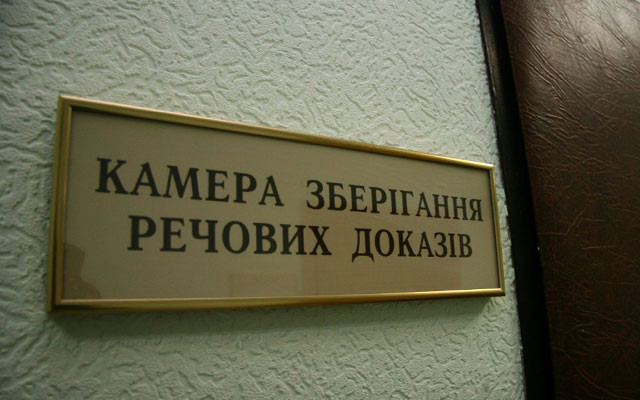
The problems of storage of material evidence by the prosecution were outlined in the UNBA

Storage of material evidence by the prosecution, its sale, technological processing, destruction, expenses related to its storage and shipment, safety of temporarily seized property and seized property...
Problematic issues in these matters are studied as part of legal monitoring by the Directorate of Justice and Criminal Justice of the Ministry of Justice. In order to find solutions, they have asked the National Bar Association of Ukraine to provide relevant proposals.
The Ministry of Justice notes that there are questions about clarifying and regulating the place of storage of: weapons (weapons, ammunition), military equipment, munitions, and their parts used in the armed aggression against Ukraine; flammable substances, including fuels and lubricants; funds in national and foreign currency, payment documents, and the regulation of the rules for the preservation of digital evidence. And law enforcement agencies are raising the issue of the need to amend the Instruction on the Procedure for Seizure, Accounting, Storage and Transfer of Material Evidence in Criminal Cases, Valuables and Other Property by the Authorities of Inquiry, Pre-trial Investigation and Court.
In terms of clarifying and regulating the place of storage of weapons, the UNBA believes that special sites should be used to preserve this category of material evidence, similar to the storage of cars and other equipment. In this case, it is necessary to provide a clear mechanism for their transfer to the state after they lose the status of material evidence for processing into metal. Records of such material evidence should be kept, including weight categories, to understand how much metal the state will receive after the investigation and litigation are completed.
With regard to flammable substances, including fuels and lubricants, it is clear that before this category of evidence is deposited for safekeeping, an expert examination must be conducted to determine its characteristics. If such evidence contains substances relevant to the investigation, samples are then taken for possible expert examination. It should be noted that fuels and lubricants do not contain individual characteristics, and therefore can be transferred for storage by volume to the relevant organizations that trade in these substances and have storage facilities. If it is necessary to return these substances to the owner, a certain amount is returned to the owner.
According to part 6 of Article 100 of the CPC, material evidence that does not contain traces of a criminal offense in the form of items, large batches of goods, the storage of which due to bulkiness or other reasons is impossible without undue difficulty or the cost of providing special storage conditions is commensurate with their value, as well as material evidence in the form of goods or products that are subject to rapid deterioration
1) returned to the owner (legal owner) or transferred to him/her for safekeeping, if possible without prejudice to criminal proceedings;
2) transferred with the written consent of the owner, and in the absence of such consent, by decision of the investigating judge or court for sale, if possible without prejudice to the criminal proceedings;
3) destroyed with the written consent of the owner, and in the absence of such consent - by decision of the investigating judge or court, if such goods or products subject to rapid deterioration are in an unusable condition;
4) transferred for their technological processing or destroyed by the decision of the investigating judge or court if they belong to items or goods withdrawn from circulation, as well as if their long-term storage is dangerous to human life or health or the environment.
Physical evidence is recorded by photographing or video recording and described in detail. If necessary, a sample of material evidence sufficient for its expert examination or other purposes of criminal proceedings may be preserved.
Cash and payment documents should definitely be stored in safe deposit boxes in state-owned bank branches. CDs, flash drives and memory cards are used to store digital evidence. Although they are supposed to be stored in designated places, in practice they are stored in case files or in investigators' offices, resulting in loss or damage. Computer equipment and mobile phones (the most acute problem) should be seized in exceptional cases when they contain traces of a crime, otherwise information should be recorded. Establishing control over the validity of the seizure of such equipment will reduce the budgetary burden and protect human rights to property.
The UNBA also emphasized the need to improve the mechanism for seizing evidence, strengthen responsibility for its preservation, and establish control over the inspection and retention of things when they have lost their value as material evidence.
A separate problematic issue with the storage of physical evidence, according to lawyers, is that after the seizure of temporarily seized property is canceled or the property is returned to the owner or possessor, there are cases when it is necessary to spend time and resources to establish its location. After all, investigators' decisions on recognizing things and documents as material evidence do not contain information about the location of things and the persons responsible for their storage. This gap can be eliminated, for example, by amending Article 110 of the CPC. In this case, the decision to recognize property as material evidence should be handed (sent) to its owner or possessor.
The full text of the UNBA's proposals, which were sent at the request of the Ministry of Justice, can be found here.
© 2025 Unba.org.ua Всі права захищені
"Національна Асоціація Адвокатів України". Передрук та інше використання матеріалів, що розміщені на даному веб-сайті дозволяється за умови посилання на джерело. Інтернет-видання та засоби масової інформації можуть використовувати матеріали сайту, розміщувати відео з офіційного веб-сайту Національної Асоціації Адвокатів України на власних веб-сторінках, за умови гіперпосилання на офіційний веб-сайт Національної Асоціації Адвокатів України. Заборонено передрук та використання матеріалів, у яких міститься посилання на інші інтернет-видання та засоби масової інформації. Матеріали позначені міткою "Реклама", публікуються на правах реклами.